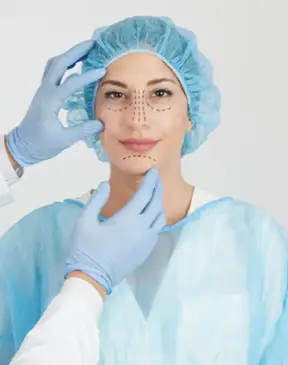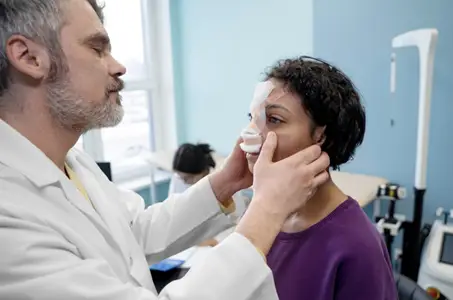Rhinoplasty Realities: Common Misconceptions and What to Expect from Your Nose Job
Rhinoplasty, commonly referred to as a nose job, is one of the most popular and transformative cosmetic surgeries available today. This procedure reshapes the nose to achieve a more balanced facial appearance, improve breathing, or correct congenital defects. However, despite its popularity, rhinoplasty is often surrounded by misconceptions that can create unrealistic expectations for those considering the procedure.
This blog aims to clarify these misconceptions and provide an in-depth understanding of what to truly expect from rhinoplasty, helping you make an informed decision on your aesthetic journey.
Common Misconceptions About Rhinoplasty
Before diving into what rhinoplasty entails, let’s address some of the most common misconceptions that often mislead patients:

Misconception 1: Rhinoplasty Will Give You the “Perfect” Nose
One of the biggest myths surrounding rhinoplasty is that it can give you the “perfect” nose. While rhinoplasty can dramatically improve the appearance of your nose, perfection is subjective, and the goal should always be harmony and balance with your facial features rather than achieving a one-size-fits-all ideal.
Everyone’s facial structure is unique, and a nose that looks beautiful on one person might not suit another. A skilled surgeon will tailor the procedure to enhance your overall appearance, ensuring that the final result looks natural and complements the rest of your features.
Misconception 2: Rhinoplasty Is Only for Aesthetic Purposes
Although many people pursue rhinoplasty to improve the appearance of their nose, the procedure can also address functional issues. For individuals with breathing difficulties, a deviated septum, or congenital nasal defects, rhinoplasty can significantly improve their quality of life by enhancing nasal function.
In many cases, rhinoplasty combines both aesthetic and functional goals. For example, a patient may undergo surgery to correct a deviated septum while also refining the shape of their nose. This combination of form and function is a hallmark of successful rhinoplasty.
Misconception 3: Rhinoplasty Is a Quick Fix with Minimal Recovery Time
Another common misconception is that rhinoplasty is a quick, easy procedure with little downtime. In reality, rhinoplasty is a complex surgery that requires careful planning and precision, both during and after the operation.
The recovery process can take several weeks, and while the initial results may be visible within a few weeks, it can take up to a year for the final results to fully emerge as swelling gradually subsides. Understanding that rhinoplasty is a long-term commitment, both in terms of surgery and recovery, is essential for setting realistic expectations.
Misconception 4: Rhinoplasty Results Are Always Permanent
While rhinoplasty can deliver long-lasting results, it’s important to understand that no cosmetic procedure can completely halt the natural aging process. Over time, the nose may change slightly due to factors such as aging, weight fluctuations, or trauma. However, with proper care and a healthy lifestyle, the results of your rhinoplasty can be enjoyed for many years.
What to Expect Before, During, and After Rhinoplasty
Now that we’ve addressed some common misconceptions, let’s walk through the rhinoplasty journey, outlining what you can expect before, during, and after the procedure.

Before the Procedure: The Consultation
The first step in your rhinoplasty journey is a consultation with a board-certified plastic surgeon. This consultation is a critical opportunity for you to discuss your goals, concerns, and expectations for the procedure. Your surgeon will evaluate your nasal structure, facial proportions, and overall health to determine whether you are a good candidate for rhinoplasty.
During the consultation, you should expect:
- A Physical Examination: Your surgeon will examine your nose, both externally and internally, to assess its shape, size, and structure. They may also evaluate your breathing to determine if functional improvements are needed.
- Medical History Review: Your surgeon will ask about your medical history, including any previous nasal surgeries, allergies, or breathing issues. It’s important to be honest and thorough, as this information will guide the surgical plan.
- Discussion of Goals: You will have the opportunity to discuss your aesthetic goals with your surgeon. Whether you want to reduce the size of your nose, refine the tip, or correct a bump on the bridge, your surgeon will work with you to create a personalized treatment plan.
- Explanation of the Procedure: Your surgeon will explain the rhinoplasty procedure in detail, including the different techniques that may be used, such as open or closed rhinoplasty. They will also discuss the expected results and potential risks associated with the surgery.
By the end of your consultation, you should have a clear understanding of the procedure, the expected outcomes, and the recovery process. If you decide to move forward, your surgeon will schedule the surgery and provide you with pre-operative instructions.
During the Procedure: The Surgery
On the day of your rhinoplasty, you will arrive at the surgical facility or hospital, where the procedure will be performed. Rhinoplasty can be performed under general anesthesia or local anesthesia with sedation, depending on the complexity of the surgery and your surgeon’s recommendation.
Here’s what to expect during the procedure:
- Incisions: Depending on the technique used, your surgeon will make incisions either inside the nostrils (closed rhinoplasty) or across the columella, the strip of tissue that separates the nostrils (open rhinoplasty). The choice of technique will depend on the specific changes being made to the nose.
- Reshaping the Nose: Once the incisions are made, your surgeon will carefully reshape the bone, cartilage, and tissue of the nose to achieve the desired result. This may involve removing or adding tissue, refining the nasal tip, or correcting a deviated septum.
- Closing the Incisions: After the necessary changes have been made, the incisions will be closed with sutures, and the nose may be supported with splints or packing to help maintain its new shape as it heals.
The duration of the surgery can vary depending on the complexity of the procedure, but it typically takes between one and three hours.

After the Procedure: The Recovery
Recovery from rhinoplasty is a gradual process, and it’s important to be patient and follow your surgeon’s post-operative instructions to ensure optimal healing.
Here’s what to expect during the recovery process:
- Immediate Post-Surgery: After the surgery, you will be taken to a recovery room, where medical staff will monitor you as the effects of anesthesia wear off. You will be allowed to go home the same day, but you will need someone to drive you home and stay with you for the first 24 hours.
- Swelling and Bruising: It’s normal to experience swelling, bruising, and discomfort in the days following rhinoplasty. The swelling may initially be more pronounced, especially around the eyes and nose, but it will gradually subside over the following weeks.
- Pain Management: Your surgeon will prescribe pain medication to help manage any discomfort during the initial recovery period. You may also be instructed to use cold compresses to reduce swelling.
- Follow-Up Appointments: You will have follow-up appointments with your surgeon to monitor your healing progress and remove any splints or sutures. These appointments are essential for ensuring that you are healing properly and addressing any concerns that may arise.
- Resuming Activities: Most patients can return to light activities within one to two weeks, but it’s important to avoid strenuous exercise, heavy lifting, or any activities that could impact the nose for several weeks. Your surgeon will provide specific guidelines on when it’s safe to resume normal activities.
- Final Results: While you will notice an improvement in the appearance of your nose within a few weeks, it can take up to a year for the final results to fully emerge as the swelling continues to subside and the tissues settle.
Conclusion
Rhinoplasty is a powerful and transformative procedure that can enhance your appearance and improve your quality of life. By understanding the realities of rhinoplasty, including common misconceptions and what to expect before, during, and after the procedure, you can make an informed decision and set realistic expectations for your results.
If you’re considering rhinoplasty, consulting with a qualified and experienced plastic surgeon like Dr. Ashish Ghuge is the first step towards achieving the beautiful, balanced nose you’ve always wanted. Dr. Ghuge can guide you through each stage of the process, ensuring that your rhinoplasty journey is a positive and successful experience.